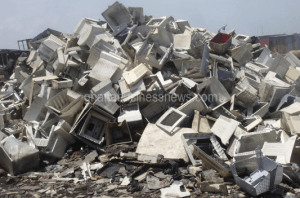171,000 tons of e-waste in Ghana – Report

A new comprehensive assessment report of the e-waste situation in Ghana has found that 171,000 tons of e-waste reaches the country’s informal recycling sector, adding that the amount of material that reaches the formal recycling sector accounted only for 0.2%.
Informal recyclers operating in the country collect obsolete electronics and electrical equipment, dismantle them and remove valuable parts. They often burn cables to extract copper wires for sale. They do these in the open and without any protective clothing, despite the inherent dangers that they are possibly exposed to from the toxic chemicals contained in e-waste.
The report which gathered data from Ghana’s ports of entry, electronics sales points, Customs, Excise and Preventive Services (CEPS) among others says the electronics and electrical equipment (EEE) imports into Ghana in 2009 added up to 215,000 tons and a per capita import of 9kg.
According to the report released in March 2011, about 30% of the imports comprised of new products and 70% second hand EEE. Around 15% of the second hand imports was estimated to be unsellable. The unsellable items, the report described as those that would not respond to power, are broken or outdated. It also found that a significant portion of these were destined directly to the informal recycling sector. Another 20% of the imports can be serviced (repaired/refurbished) to get them functioning, it adds.
The report also found that of the 280,000 tons of obsolete devices generated in 2009, 57% went to repair, 8% to storage and 34% directly to recycling via the informal collectors. Only 1% was collected via communal collection.
On the laws governing e-waste, the report said “there are a number of laws and regulations that have some relevance to the control and management of hazardous wastes, including e-waste, “but they do not address the dangers posed to humans and the environment from such wastes.”
Ghana also has unrestricted and unregulated import regime for second hand electronics and electrical items, the report established.
It however indicates among other things that a national E-waste strategy to provide policy and management of WEEE direction nationwide has been developed in a separate document with the following objectives: to establish an institutional framework for collaboration in controlling importation of used electronics and electrical items; create awareness on the dangers of the current handling process, the new hand-in/take back system and on recycling centres at all levels of governance and the public; develop a policy on general importation and management of (W)EEE and on hazardous substances.
The report was written by Green Ad, a Ghanaian NGO, the Environmental Protection Agency (EPA) of Ghana and the Swiss Federal Laboratories for Materials Testing and Research (EMPA).
It is known that 20 to 50 million tons of e-waste are generated in the world annually and a great amount of that ends up in developing countries including Ghana and Nigeria.
By Emmanuel K. Dogbevi

Thanks for the article and the resource.